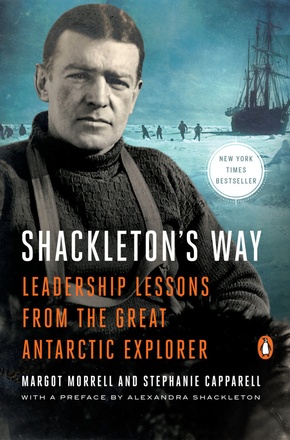
Shackleton's Way - Leadership Lessons from the Great Antarctic Explorer. With a Preface by Andrea Shackleton
| Verlag | Penguin UK |
| Auflage | 2002 |
| Seiten | 256 |
| Format | 20,5 cm |
| Gewicht | 194 g |
| Artikeltyp | Englisches Buch |
| Reihe | A New York Times Business Bestseller |
| ISBN-10 | 0142002364 |
| EAN | 9780142002360 |
| Bestell-Nr | 14200236EA |
Lead your business to survival and success by following the example of legendary explorer Ernest Shackleton
Sir Ernest Shackleton has been called "the greatest leader that ever came on God's earth, bar none" for saving the lives of the twenty-seven men stranded with him in the Antarctic for almost two years. Because of his courageous actions, he remains to this day a model for great leadership and masterful crisis management. Now, through anecdotes, the diaries of the men in his crew, and Shackleton's own writing, Shackleton's leadership style and time-honored principles are translated for the modern business world. Written by two veteran business observers and illustrated with ship photographer Frank Hurley's masterpieces and other rarely seen photos, this practical book helps today's leaders follow Shackleton's triumphant example.
"An important addition to any leader's library." -Seattle Times
Inhaltsverzeichnis:
Shackleton's WayPreface by the Honorable Alexandra Shackleton
Introduction
Shackleton resonates with executives in today's business world. His people-centered approach to leadership can be a guide for anyone in a position of authority. Some of today's leaders are successfully applying Shackleton's methods to their own work situations.
1. The Path to Leadership
The values Shackleton learned from his family helped form his uniquely progressive leadership style. He worked his way into the forefront of a new field. He turned bad experiences into valuable work lessons. He insisted on respectful competition in a business climate that often demanded cooperation.
Former U.S. Secretary of the Navy Richard Danzig sees Shackleton's broad cultural interests as a main ingredient of thoughtful leadership.
2. Hiring an Outstanding Crew
Shackleton built a crew around a core of experienced workers. He conducted unconventional interviews to find unique talent. His second in command was his most important hire. He looked for optimism and cheerfulness in the people he hired. He gave his staff the best compensation and equipment he could afford.
James Cramer credits Shackleton's optimistic example with saving his hedge fund and TheStreet.com from an early demise.
3. Creating a Spirit of Camaraderie
Shackleton made careful observations before acting. He established order and routine so all workers knew where they stood. He broke down traditional hierarchies. He was fair in his dealings with his staff. He used informal gatherings to build espirit de corps.
Eric Miller, a senior adviser at Donaldson, Lufkin & Jenrette, sees Shackleton's strategy as fitting well into today's workplace.
4. Getting the Best from Each Individual
Shackleton led by example. He understood and accepted his crewmen's quirks and weaknesses. He used informal one-on-one talks to build a bond with his men. He was always willing to help others get their work done. He helped each man reach his potential.
Luke O'Neill runs Shackleton Schools in New England to put into practice Shackleton's message about individual achievement.
5. Leading Effectively in a Crisis
Shackleton let everyone know that he was in charge and confident of success. He inspired optimism in everyone. He put down dissent by keeping the malcontents close to him. He got everyone to let go of the past and focus on the future. He worked to keep spirits high. He sometimes led by doing nothing.
Jeremy Larken of Octo Ltd. uses Shackleton as a model for intelligent leadership facing a crisis.
6. Forming Teams for Tough Assignments
Shackleton balanced talent and expertise in each team. He ensured all his groups were keeping pace. He remained visible and vigilant. He shored up the weakest links. He got teams to help each other.
Apollo 13 commander James Lovell sees similarities in how Shackleton and he led their crews through crises.
7. Overcoming Obstacles to Reach a Goal
Shackleton took responsibility for getting the whole job done. Even "Old Cautious" sometimes took big risks. He found the inspiration to continue. He kept sight of the big picture. He stepped outside his work to help others.
Jaguar's retired chief of North American operations, Mike Dale, used Shackleton's story to spur his sales crew to new heights.
8. Leaving a Legacy
Shackleton's leadership had a lifelong impact on his crew. His appeal spans generations. His lasting contributions to leadership. He influenced a pioneer project in space. Using his example to promote social change. How we view Shackleton's success today.
Shackleton's Crews
Bibliography
Acknowledgments
Index
